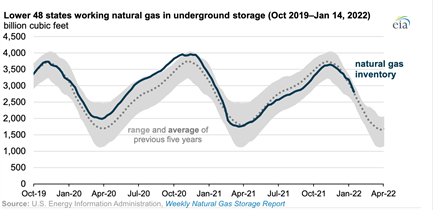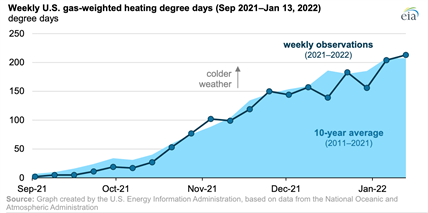U.S. natgas inventories near five-year average after mild December, cold January

After starting the winter heating season (November–March) below its previous five-year average, the Lower 48 states' working natural gas in storage surpassed its five-year average in mid-December during one of the warmest Decembers on record. However, colder-than-normal temperatures in early January, along with increased LNG exports and increased power demand compared with last year, have lessened these gains, and working natural gas is again less than the five-year average.
Working natural gas stored in the Lower 48 states totaled 2,591 Bft3 as of January 21, based on data from the EIA's weekly natural gas storage report. As of January 21, natural gas in storage was 25 Bft3, or 1%, less than its previous five-year (2017–2021) average for the week. At the beginning of the heating season on November 5, natural gas in storage was 3,618 Bft3, or 3%, less than its previous five-year average.
Significantly warmer-than-normal temperatures during the early weeks of the heating season lessened space heating demand for natural gas and withdrawals from U.S. natural gas inventories. Heating degree days measure the relative coldness of winter seasons. The National Oceanic and Atmospheric Administration reported 635 cumulative gas-weighted heating degree days for the Lower 48 states from December 3 to 30, or 12% less than (that is, warmer than) the previous 10-year average.
Natural gas demand in the U.S. residential and commercial sectors averaged 34.5 Bft3d in December, which is 15% less than the previous five-year average, according to data from IHS Markit. The decreased demand for natural gas in these sectors resulted in lower withdrawals of natural gas from storage compared with the five-year average.

Record-high LNG exports limited increases in U.S. natural gas inventories, despite a much warmer-than-normal December and high natural gas production in the Lower 48 states. The EIA estimates that U.S. LNG exports averaged 11 Bft3d from November through January in response to high prices in both Asia and Europe. In particular, inventories in Europe remain much lower than their five-year averages and contributed to increased demand for LNG.
Starting in early January, colder-than-normal temperatures in the Midwest and Northeast U.S. have led to more natural gas demand for space heating, while LNG exports have remained at elevated levels. Net withdrawals from storage exceeded the five-year average in the first three weeks of January by 25%, bringing storage inventories to within 1% of the five-year average.
The EIA forecasts working natural gas inventories in the Lower 48 states will total 1,795 Bft3 at the end of March, which would be 128 Bft3 (7%) more than the five-year (2017–21) average.
Principal contributor: Max Ober

- ADNOC Gas awards $2.1 B in contracts to enhance LNG supply infrastructure
- U.S. Department of the Treasury releases final rules for clean hydrogen production tax credit
- Tecnimont to build waste-to-biogas plant to fuel local kitchens in India
- Indonesia regulator confirms disruption at bp's Tangguh LNG project
- Topsoe, Aramco sign JDA to advance low-carbon hydrogen solutions using eREACT™



Comments